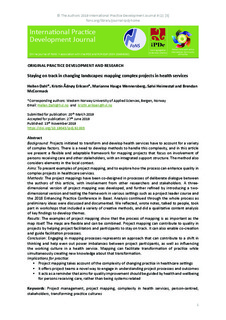| dc.contributor.author | Dahl, Hellen | |
| dc.contributor.author | Eriksen, Kristin Ådnøy | |
| dc.contributor.author | Wennersberg, Marianne Hauge | |
| dc.contributor.author | Heimestøl, Sølvi | |
| dc.contributor.author | McCormack, Brendan | |
| dc.date.accessioned | 2020-02-11T13:03:46Z | |
| dc.date.available | 2020-02-11T13:03:46Z | |
| dc.date.created | 2019-11-20T12:31:19Z | |
| dc.date.issued | 2019 | |
| dc.identifier.citation | International Practice Development Journal. 2019, 9 (2). | nb_NO |
| dc.identifier.issn | 2046-9292 | |
| dc.identifier.uri | http://hdl.handle.net/11250/2641054 | |
| dc.description | This article by Hellen Dahl, Kristin Ådnøy Eriksen, Marianne Hauge Wennersberg, Sølvi Heimestøl and Brendan McCormack is licensed under a Creative Commons Attribution Non-Commercial 3.0 License. | nb_NO |
| dc.description.abstract | Background: Projects initiated to transform and develop health services have to account for a variety of complex factors. There is a need to develop methods to handle this complexity, and in this article we present a flexible and adaptable framework for mapping projects that focus on involvement of persons receiving care and other stakeholders, with an integrated support structure. The method also considers elements in the local context. Aims: To present examples of project mapping, and to explore how the process can enhance quality in complex projects in healthcare services. Methods: The project mappings have been co-designed in processes of deliberate dialogue between the authors of this article, with involvement from other researchers and stakeholders. A three- dimensional version of project mapping was developed, and further refined by introducing a two-dimensional version and testing the framework in various settings such as a project leader course and the 2018 Enhancing Practice Conference in Basel. Analysis continued through the whole process as preliminary ideas were discussed and documented. We reflected, wrote notes, talked to people, took part in workshops that included a variety of creative methods, and did a qualitative content analysis of key findings to develop themes. Results: The examples of project mapping show that the process of mapping is as important as the map itself. The maps are flexible and can be combined. Project mapping can contribute to quality in projects by helping project facilitators and participants to stay on track. It can also enable co-creation and guide facilitation processes. Conclusion: Engaging in mapping processes represents an approach that can contribute to a shift in thinking and help even out power imbalances between project participants, as well as influencing the working culture in a health service. Mapping can facilitate transformation of practice while simultaneously creating new knowledge about that transformation. | nb_NO |
| dc.language.iso | eng | nb_NO |
| dc.rights | Navngivelse-Ikkekommersiell 4.0 Internasjonal | * |
| dc.rights.uri | http://creativecommons.org/licenses/by-nc/4.0/deed.no | * |
| dc.title | Staying on track in changing landscapes: mapping complex projects in health services | nb_NO |
| dc.type | Journal article | nb_NO |
| dc.type | Peer reviewed | nb_NO |
| dc.description.version | publishedVersion | nb_NO |
| dc.rights.holder | © The Authors 2019 | nb_NO |
| dc.source.pagenumber | 20 | nb_NO |
| dc.source.volume | 9 | nb_NO |
| dc.source.journal | International Practice Development Journal | nb_NO |
| dc.source.issue | 2 | nb_NO |
| dc.identifier.doi | 10.19043/ipdj.92.003 | |
| dc.identifier.cristin | 1749860 | |
| cristin.unitcode | 222,56,1,0 | |
| cristin.unitname | Institutt for sykepleie- og helsevitenskap | |
| cristin.ispublished | true | |
| cristin.fulltext | original | |
| cristin.qualitycode | 1 | |

